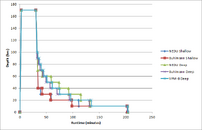The trend away from deep stop profiles, whether they are calculated by UTD Ratio Deco, GFs, VPM, RGBM, BVM, etc., is certainly understandable following the results of the NEDU study. However, most of us are still diving something like Buhlmann GF profiles where GF-low is substantially lower (typically half to two-thirds) than GF-high. Something in the ballpark of 40/75.
I used Subsurface to match as closely as possible the shallow and deep stop profiles from the NEDU study with GF and VPM-B deco models, and the "fit" is not what many people would expect.
The shallow stops profile fits a Buhlmann GF 100/44 plan very closely. Yes, the numbers are the right way around: GF-low is more than twice the value of GF-high! I know nobody that plans dives with anything like that.
The deep stops profile gets an ok match (bubble model fans may disagree) to either Buhlmann GF 20/65 (at sea level), or VPM-B +4 (most conservative setting in Subsurface and GUE DecoPlanner) with the altitude set to 9500ft/2900m to increase the conservatism further. I say bubble model fans may disagree because the NEDU deep stop profile is nearly consistently 10ft deeper than either the GF20/65 or VPM-B +4 profiles between 50-115 minutes (i.e. the "intermediate stop" part of the ascent schedule).
Personally, I claim not to favour deep stops or bubble models (I typically plan with GF 60/85, but will accept anything more conservative my buddies propose), but ask me whether I'd rather plan and execute a dive with GF 100/44 or 20/65, and I'd choose the latter any day. I suspect most people in this thread would do likewise.
Maybe we should be getting shallower even earlier than we think.
All profiles plotted in Excel below




